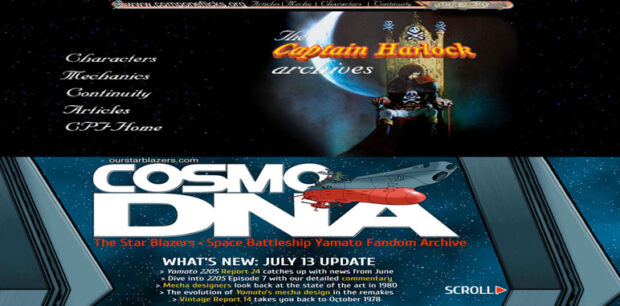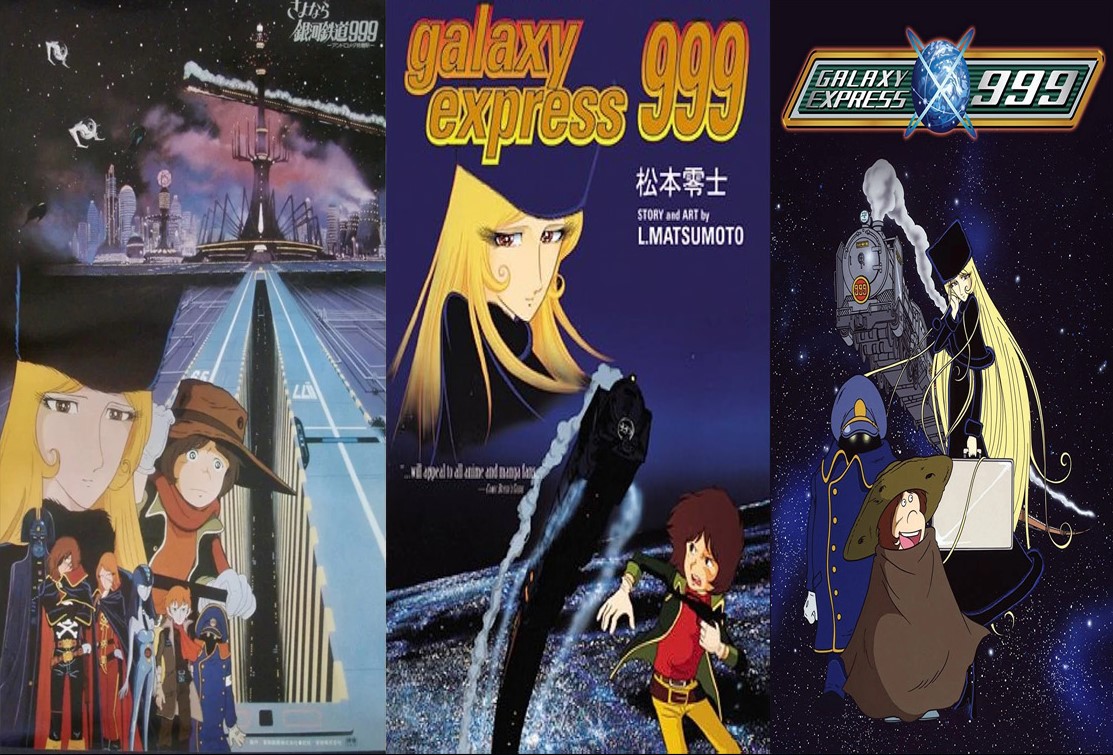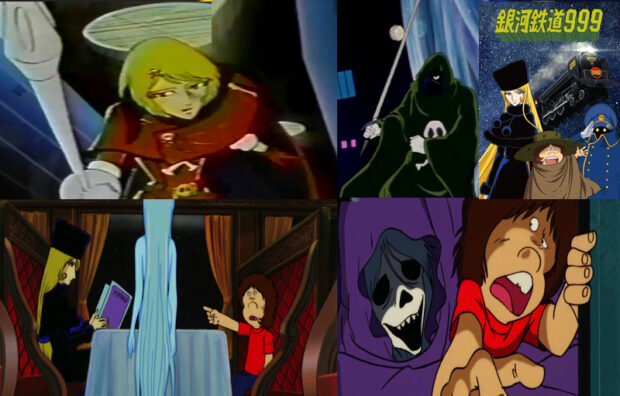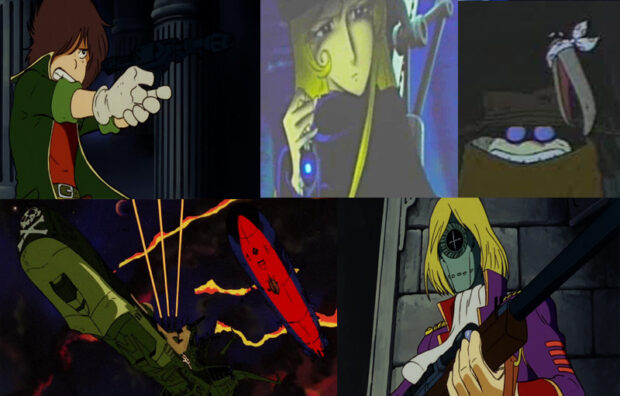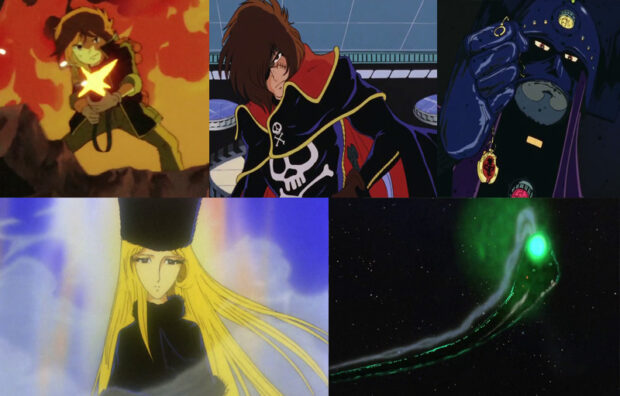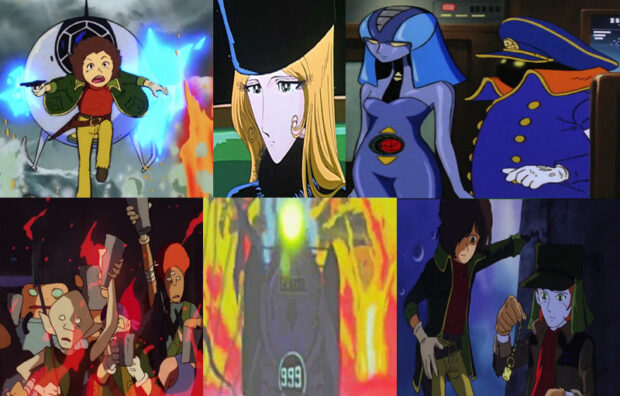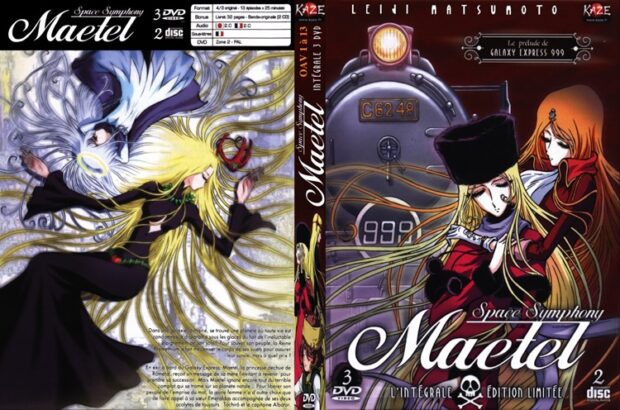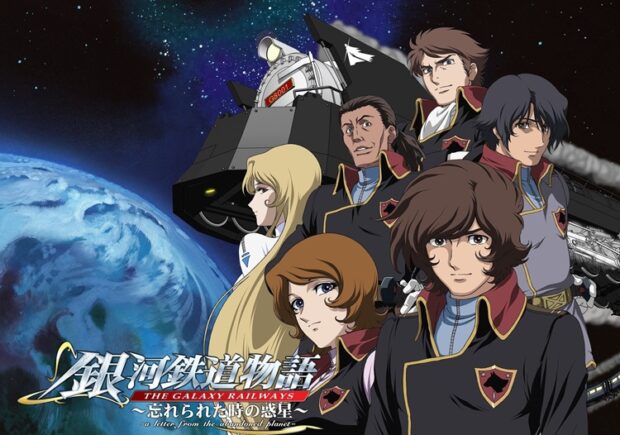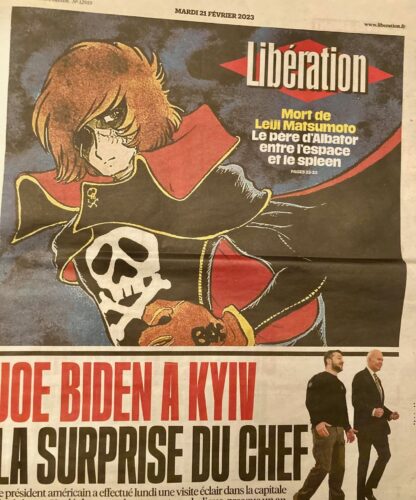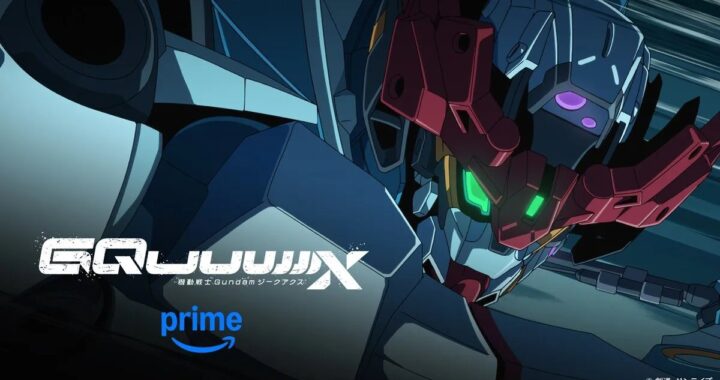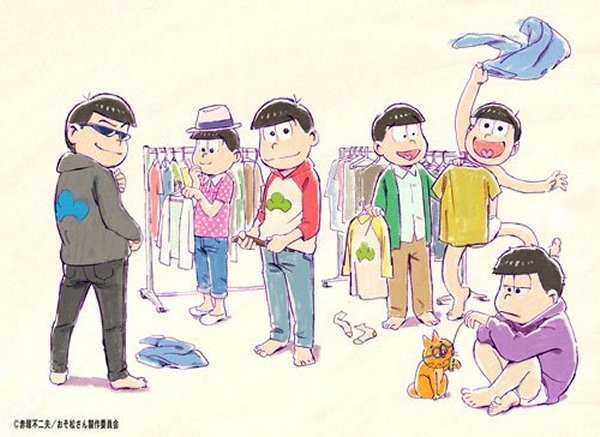The Galaxy Express three-9 will take you on a journey, a neverending jour-ney… a journey to the starrrrs!
Hey everyone. Although it’s been a few years since the 40-year mark, the first theatrical film of Galaxy Express 999 turned 45 recently and it seemed like a good time to take a look at its history and how the franchise changed space opera forever. Warning though for those who are not into such concepts – the series revolves around a steam locomotive that flies through space, as the title suggests. So yeah, there are elements that lean more toward fantasy than anything else. If you’re not one that can accept this, might as well quit reading now. The franchise never wavers from this and indeed adds fantastic elements over time. But you’ll be missing out on something cool if you do stop…
… still here? Good. Let’s begin.
Taking place about 1000 years in the future, humanity has expanded across the stars and interacts with aliens quite frequently. People travel on different Galaxy Railways, which mostly look like bullet trains. The 999 though looks like a steam locomotive and has a singular final destination for anyone who wishes to ride it: the acquisition of a machine body in which people can live forever. As this obviously has a longer term than limited organic existence, many folks take advantage and soon become the dominant life on Earth, especially the ones who have the money to do so. There are still many others though who are not as financially well off and eeke out a meager existence in the alleys of Megalopolis, the Earth station where trains come and go.
This is where we’re introduced to our hero Tetsuro Hoshino, a little boy walking in a wintry field with his mother, talking of hopes to save enough for a machine body. Suddenly, they’re attacked by the vicious Count Mekka, a mechanized hunter who kills humans for sport. He shoots Tetsuro’s mother but is unable to find the adolescent, opting to return home and mount the body on his trophy wall. Tetsuro winds up in the home of a mysterious woman named Maetel, who restores him to health before he grabs a machine gun and goes to get his revenge. Afterward, Maetel tells Tetsuro she needs an escort on the 999 and asks him to come along in exchange for an unlimited pass. So the pair head off into space for a journey full of all kinds of adventures.
Galaxy Express 999 is the brainchild of manga creator Leiji Matsumoto. Born under the name Akira Matsumoto, he was inspired by American comics and began drawing at age 8 often tinkering with a character back then whom he eventually called Captain Kingston or Doctor Kingston, while marching home with the name Captain Harlock coming out eventually. His father was a well-paid pilot until he left the aviation industry due to the deaths of people he trained in WW2. He never returned to that job which left his family impoverished and young Akira to have a slightly rough childhood. Growing up though, the young boy would collect American comics and read novels by Juzo Unno, H.G. Wells, and Arthur Conan Doyle. He began his manga career drawing for the school newspaper at age 15 and then in 1953 won a drawing contest in ‘manga shonen’ magazine for his 16-page manga ‘Mitsubachi no Boken’ known as ‘Adventures of a Honeybee’ which got him discovered. Many kids liked insects back then it seems, with all the mecha designs based on them in later years, and young Matsumoto was no exception.
This started his path to making manga professionally under his real name. He left town on the train he grew up watching and went on to write manga… for girls. As he’d aspired to develop characters and concepts he’d tinkered with many years before, this was not entirely the path he’d envisioned. He did get valuable experience though and had an interesting encounter with two great talents: namely Osamu Tezuka and Shotaro Ishimori. The trio got into animation by buying a bunch of Disney, Fleischer and Soviet animation movies to study techniques. However, a foreign affairs investigator thought they were black marketeers and initially wanted to jail them but the group explained they were collecting for research purposes.
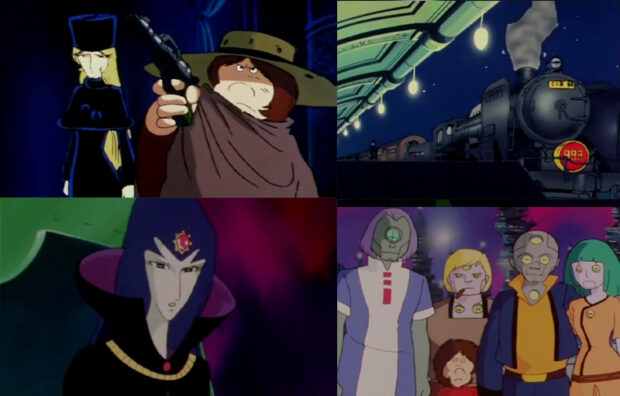 As he got frustrated and left the shoujo industry behind, Akira Matsumoto decided to forego his first name and changed it to Leiji. (Lei = zero, ji = samurai. Also ‘lei’ means void as in what he’d want to do regarding all the girl’s manga he drew.) He did a manga entitled ‘Otoko Oidon’ (or I Am A Man) about a kid who fails college entrance exams and becomes a ronin trying to get in. He also created other titles such as Sexaroid, Shadow Warrior, and Out of Galaxy Koshika. This got him noticed and soon he was recruited to work on a new sci-fi TV project: the now-legendary Space Battleship Yamato. He created and re-designed characters, storyboards, and ship designs for the project, which eventually had several sequel series and films.
As he got frustrated and left the shoujo industry behind, Akira Matsumoto decided to forego his first name and changed it to Leiji. (Lei = zero, ji = samurai. Also ‘lei’ means void as in what he’d want to do regarding all the girl’s manga he drew.) He did a manga entitled ‘Otoko Oidon’ (or I Am A Man) about a kid who fails college entrance exams and becomes a ronin trying to get in. He also created other titles such as Sexaroid, Shadow Warrior, and Out of Galaxy Koshika. This got him noticed and soon he was recruited to work on a new sci-fi TV project: the now-legendary Space Battleship Yamato. He created and re-designed characters, storyboards, and ship designs for the project, which eventually had several sequel series and films.
Years later with more experience under his belt, he was able to get two of his longtime creations onto television. In March 1978, Toei Animation presented Space Pirate Captain Harlock on TV Asahi. Through 42 episodes we got to see Matsumoto’s hero command his battleship the Arcadia against alien invasion. Adapted from his manga serialized in Play Comic, this was the first time viewers got to see some of the perennial characters and archetypes that formed the ‘Leijiverse” as it’s come to be known over time. Most notable are the anime debuts of Tochiro and Emeraldas. Matsumot’s penchant for slim long-haired female characters was very prominent as this stemmed from a childhood crush on popular German actress Marianne Hold, whom he saw in the 1955 film Marianne of My Youth. We also meet people who fans have come to call ‘potato heads’, mostly short people whose heads take up much of their design. It’s likely several of them are based on real people. For example, the Arcadia’s chief engineer Yatteran is based directly on Matsumoto’s protege’ Kaoru Shintani, who went on to create the air combat manga Area 88. Matsumoto’s kids instantly recognized the similarities so this likely was an accurate depiction to some degree.
Captain Harlock became such a cultural mainstay that later in the same year, Toei was able to get Matsumoto’s other big creation onto TV. September of ‘78 saw the debut of Galaxy Express 999 on Fuji TV. Inspired partly by the cat-filled fantasy novel Night On The Galactic Railroad by Kenji Miyazawa and directed by Nobutaka Nishizawa (Gegege no Kitaro, Mazinger Z vs Black General), the series lasted 113 episodes and a few mini-movies making it one of the most successful shows of the time, even more so than Captain Harlock. Also known as Ginga Tetsudo (literally translated as Milky Way Road) 999, this iteration written by Hiroyasu Yamaura, Keisuke Fujikawa, and Yoshiaki Yoshida saw Tetsuro dispatch Count Mekka and be recruited by Maetel to ride for the adventure-of-the-week format, keeping viewers coming back for new planets like Star Trek episodes before ending his journey.
This adaptation led to the creation of a theatrical film of Galaxy Express 999 being released on on August 4, 1979. Rintaro returned to animate more of the Leijiverse with entirely new footage for some very nice results. The script by Fumio Ishimori focused largely on Tetsuro and Maetel’s hunt for Count Mekka and their meeting Promecium, Queen of the Mechanized Empire that gives humans machine bodies. They do make some interesting stops along the way while meeting the Matsumoto mainstays. There’s a couple musical interludes giving the youthful sense of discovery. The different locales range from Wild West to frozen tundras. Personally I think my favorite scene though is the somewhat creepy sequence when Tetsuro enters Count Mekka’s Time Castle, which is full of dark, dank artwork while the haunting score by Nozomu Aoki plays in the background.
This film played a significant role in altering Matsumoto’s works afterward. Regarding ship designs of Captain Harlock’s Arcadia and the Queen Emeraldas, there was a dispute about rights and profits among the toy and model makers. So Studio Nue (known for creating Cusher Joe and Macross designs, among others) was commissioned to make new ones that debuted here, hence The Arcadia becoming green and The Queen Emeraldas being blue and orange. So these were the same ships, much like the design changes between the TV series Gundam Wing and the OAV Endless Waltz The GE999 movie also had a tremendous effect on Japan’s box office, becoming the highest-grossing film of 1979.
The late 70’s/early 80’s became a golden age of Matsumoto-inspired anime. The origin story of Captain Harlock was told in a film entitled Arcadia of My Youth, which in turn led to a sequel TV series Eternal Orbit SSX. Around the same period, there was another anime called Queen Millennia, The Queen of 1000 Years which was adapted as a TV show and subsequently a movie compilation. Also, the Space Battleship Yamato Franchise was still continuing with the films Be Forever Yamato and Final Yamato.
Among all this, Rintaro directed the sequel movie Adieu Galaxy Express 999, which had improved animation over its predecessor and was a stark contrast to the first. Released in 1981, Hiroyasu Yamaura’s original screenplay shows a war-torn Earth where humans fight machine men who are obsessed with wiping out organic life. During this, Tetsuro receives a message from Maetel telling him to get aboard the Galaxy Express 999. He’s initially confused since he hasn’t talked with her in quite some time. He and his human comrades fight all the way to the station and the train’s conductor tells him Maetel disappeared after their last journey. On this trip, Tetsuro sees new planets and eventually meets the enigmatic Faust the Black Knight, who controls all galaxy railways, a frightening Ghost Train, and the machine woman Metalmana, who has odd motivations for working as the train’s stewardess. The film is beautifully animated with one of the most emotionally gripping opening sequences in anime. Its orchestral score by Osamu Shoji reflects the dramatic times Tetsuro endures this time around as opposed to the largely whimsical nature of his first journey. The script feels a bit like the first film though it gives intriguing motivations behind this war. Overall it’s an enjoyable movie despite having a deus ex machina ending.
For roughly a decade, there weren’t any anime with this group of characters. However, during interviews with American periodicals like Animag (issue 6) and Animerica, Matsumoto kept giving hints that he was returning to the quasi-universe he’d created. Then in 1998 a short film entitled Galaxy Express 999: Eternal Fantasy was released in conjunction with his newest manga which he’d started in 1996. This one is frustrating as it sets up an entirely new threat that Maetel and a visibly tortured and disheveled Tetsuro must deal with after escaping Earth’s government which is now restored but corrupt. An awfully familiar battleship makes a cameo. However, no resolution or conclusion was ever animated for this storyline.
Thus began a renaissance of Matsumoto-based anime. The OAV series Queen Emeraldas finally gave the red-headed space pirate her own adventures. We get to know her a bit differently in that as she’s a lonely pirate here instead of having an all-android crew in GE999. Matsumoto once said in an interview “the reason Emeraldas doesn’t have any crew on the Queen Emeraldas is because she is one of my perfect females and I don’t want anyone around her to blur her perfection she and the ship are one entity. that’s why there’s no human crew.” Captain Herlock: Endless Odyssey depicted a quality continuity-twisting semi-sci-fi/semi-horror outing mixing aspects of the Space Pirate and SSX series. There were also a few others. For Galaxy Express specifically, there were a couple of interesting expansions. First was a 2-part OAV called Maetel Legend released in 2000. This one shows Maetel and Emeraldas as young daughters of Queen Millennium before one of her scientists introduces a techno-virus that mutates her into Promescium and begins to create the Mechanized Empire. The sisters begin a resistance movement as citizens are being conscripted to become machine people. The story continued in the 2004 TV series Space Symphony Maetel. You can read more about it in our article Space Symphony Maetel: Ten Years Later, found here. https://www.fandompost.com/2014/12/02/ten-years-later-space-symphony-maetel-anime-series/
The other expansion was the 2004 TV series Galaxy Railways. Directed by Yukio Nishimoto and written by Hideki Sonoda, GR tells about a group of soldiers called the Space Defense Force as they protect travelers of the other trains from various threats. This show was popular enough to get two seasons, though only one was released in the U.S. by Funimation. There was also a 4 part OAV series entitled Letter From The Abandoned Planet, where the SDF are sent to find the missing Galaxy Express 999. This collection, released by Discotek Media, established a connection between characters from the two shows. This would be the last anime relating to Galaxy Express to date. A trilogy of films about Galaxy Express 999, Captain Harlock, and Queen Emeraldas was to be animated and released by Gainax starting in 2019 but the worldwide covid shutdown halted production and subsequently, Gainax itself declared bankruptcy a few years later.
Right about now you’re tempted to ask what’s the canonical order of these stories. The answer is, with a couple of small exceptions, none. All these stories contradict each other drastically and you’ll just burst your brain trying to connect them all, like if you tried with say Fate/Stay Night. When asked about this, Matsumoto would say whatever is onscreen is the correct version. The anime was similar to how Osamu Tezuka would use his various characters as actors in different stories, in what he called The Star System. This is especially prominent in works like Matsumoto’s Space Western Gun Frontier and the operatic Wagner-themed Harlock Saga.
Nevertheless, the Leijiverse has become very popular in Japan. The characters are intrinsic to their pop culture with statues, decorated trains, and boat routines running through different cities on anniversaries. Matsumoto’s works were also popular in Europe where people really got into Captain Harlock in particular. The Eternal Orbit SSX series was renamed Albator there. When Leiji Matsumoto passed away in 2023, France’s top newspaper had his life as the lead story covering the front page, (with U.S. President Joe Biden’s meeting Ukrainian President Volodymyr Zelensky getting a tiny couple of columns in the lower right corner.)
In the U.S. however, Matsumoto’s work has had a bit of a tough time gaining a major foothold outside of Space Battleship Yamato. This show was released on American syndication as Star Blazers and led 80s cartoon watchers to create some of the earliest anime fan organizations here. Arcadia of My Youth was acquired by Celebrity Home Video and released in two forms. Both were English dubbed and the uncut one was retitled My Youth In Arcadia. The other had 30 minutes removed and became known as Vengeance of the Space Pirate. Both were released in video stores and made their way though the burgeoning national fan communities with occasional magazine coverage. Two other Matsumoto shows, Dangard Ace and Starzinger (AKA Spaceketeers) were shown here under Jim Terry’s “Force Five” banner. In the mid-80s, Harmony Gold licensed Space Pirate Captain Harlock and Queen Millennia and edited them into one series for daily syndicated showings, ignoring the fact the two shows actually took place 1000 years apart.
Galaxy Express 999’s path to America has been just as interesting. Harmony Gold acquired the mini-movies and dubbed a couple of them but they didn’t get much distribution. A few years prior in 1982, the first theatrical film was licensed to Roger Corman’s New World Pictures, the same company which would later acquire Hayao Miyazaki’s Nausicaa and the Valley of Wind and retitle it into the badly edited Warriors of the Wind. Galaxy Express also was edited down by 30 minutes (even the 999 was taken from its title) and given an infamously bad dub. Tetsuo’s new name was Joey Hanabanacamada Smith (yes, he actually says all that) as he goes around meeting new heroes like Captain Warlock (who enjoys doing John Wayne impressions). It seemed all hope for a faithful translation would be lost until 1996 when Viz Media released both films on VHS with a much more accurate dub by Ocean Studios. Talents such as Saffron Henderson, Kathleen Barr and Scott McNeil among others gave good performances for Matsumoto fans and newcomers to enjoy. More new fans were made when the Sci-Fi Channel showed the GE999 films during their anime programming blocks hosted by American idol singer Apollo Smile, which made for entertaining times during the 90s. Viz Media also was running the recent (at the time) GE999 manga Matsumoto had been doing in Animerica magazine before they published it as 4 volumes.
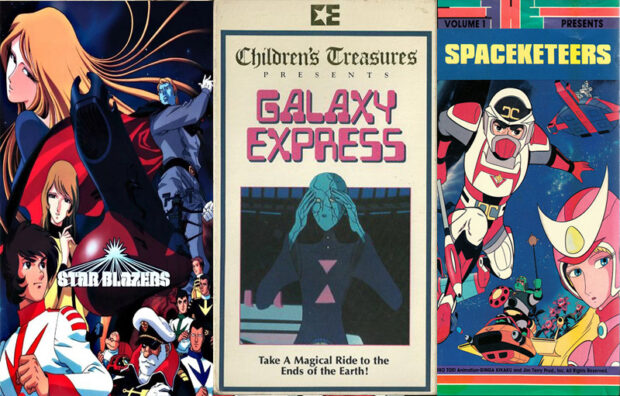
Eventually, as technology evolved, licenses changed hands, and companies rose and fell, VHS fell in favor of DVDs, then Blu-rays and streams. Thanks to ADV Films, Voyager Entertainment, Central Park Media, and Media Blasters, many Matsumoto titles made it to the U.S. on these formats. Discotek Media imported all of the Galaxy Express 999 TV shows and films, including Eternal Fantasy for which they commissioned an English Language dub by Sound Cadence. This gave rise to new voices like Lisa Ortiz, Emily Fajardo, Kent Williams, and Melissa Sternenberg as the classic characters. Again, the results were pretty good which makes it all the more frustrating that the story was never finished. Equally frustrating was the fact that Leiji Matsumoto’s fame didn’t translate to mainstream fandom in the U.S. market due to his long-running titles not being featured on Cartoon Network’s Toonami block like Dragon Ball Z, Gundam Wing, and Sailor Moon were. It was understandable as many of those works were a bit dated when Toonami was created. Still, fans here didn’t gravitate toward Matsumoto as much. Modern fans know his design style mostly from the long-form music video project Interstella 5555 with Daft Punk.
Still, in Japan, Leiji Matsumoto’s works remain some of the most influential in all of anime and manga. For example, director Rintaro went on to create epic films like Harmageddon, The Dagger of Kamui, Metropolis and Hi No Tori: The Karma Chapter. In 2013, director Shinji Aramaki made his own CG film of Space Pirate Captain Harlock. In 2012 the reboot series Space Battleship Yamato 2199 began broadcasting with a sequel show still going. Although Matsumoto’s specific character designs were not used, the inspiration of the original is clearly present. It’s fun to think of Galaxy Express 999 as the backbone of many of the journeys his characters have taken and Matsumoto’s own role in them. In Tetsuro, he’s practically a young boy traveling with a Marianne-like figure and in Tochiro he’s at the end of his journeys while being in love with another similar figure. He fulfilled the imaginations of many readers/watchers along the way. Here’s hoping newer animators re-present the stories of Galaxy Express 999 for modern fans while veterans continue to appreciate what has come before,
Til next time…
Books to read for more info…
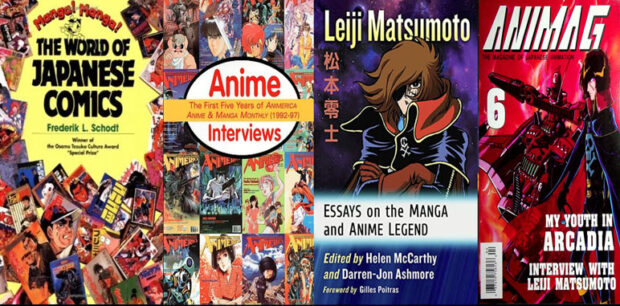
Sites to read…
